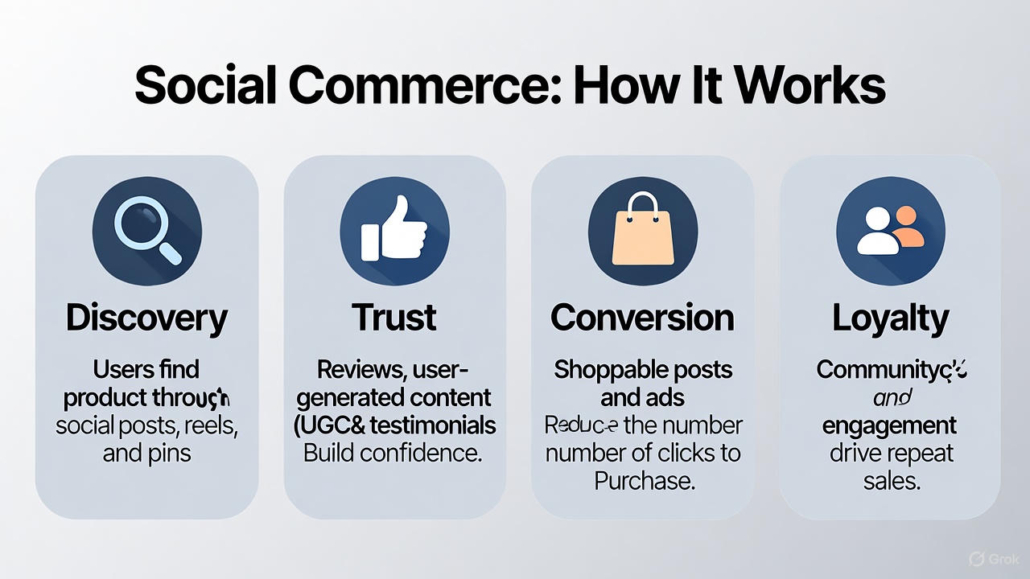The Role of Social Media in Driving E-Commerce Sales
Social media defines how individuals find and purchase products. Social networks, such as Instagram, TikTok, Facebook, and Pinterest, shape the shopping behavior of social media users. Indeed, discovery, trust, and conversion are some of the functions that e-commerce brands can use through social media.
In this guide, I will describe social commerce, paid advertising, best practices, community building, difficulties, and actual sales impact.
Social Commerce: What it is and why it matters
Use easy social media guidelines and best practices to enhance your performance. Dwelling on content that attaches itself automatically and fosters trust is worthwhile. Demo videos that demonstrate how your product functions are good since they are not complex to view or share. Testimonials and unboxing videos will help them feel more authentic, and behind-the-scenes content will provide the followers with a better look into your brand. Comparisons of the products and how to also serve to inform your audience, and offers with expiry generate urgency, leading to swift action.
To implement them practically, captions should be short and precise to your point to have an immediate picture of the message when you look. A powerful call to action should also be added to direct the user to the next action. Fit your creative style into the norms of each platform in order to enhance engagement. A/B test various creatives and variations on copy to find one that works best. Be sure to have a similar brand appearance on all the posts so as to gain recognition and trust in the long run.
Platform features that matter:
- Instagram Shops and product tags.
- TikTok shopping and live shopping.
- Facebook Shops and Marketplace integrations.
- Pinterest product pins and buyable pins.
Why social commerce matters:
- Reduces clicks between discovery and purchase.
- Uses social proof like comments and UGC to boost trust.
- Leverages platform algorithms to reach new customers.

Advertising: How paid ads and strategies boost e-commerce sales
Paid social ads are vital for scaling. Ads put your product in front of targeted audiences. A strong paid social strategy includes creative, targeting, and measurement.
Key steps to build a paid social ad strategy that works:
- Define your objective. Is it consciousness, traffic or conversions?
- Select the correct platform for your audience.
- Have platform-appropriate creative. Vertical TikTok videos. The best Instagram images and carousels.
- Establish the correct targeting and exclusions. Retargeting and use of lookalike audiences.
- Measure and iterate. Monitor ROAS, CPA, and conversion rates.
Paid ads help with social media and online shopping by driving qualified traffic. They also feed organic growth when users share posts or tag friends.
Best Practices with Packaging
Product packaging often influences conversion and shareability. Use high-quality, brand-matched packaging in product shots. For apparel brands, include a direct link to custom apparel boxes in your product pages and posts to improve unboxing content and brand recognition.
Building Community: Grow followers and tailor profiles for branding
The creation of a robust community within social media is one way of converting casual followers into loyal customers. The first thing that you should do is to post useful and popular content regularly. Share product tips, stories of success, and user-generated posts so that the followers feel that they are being involved. As an example, a pizza brand can post photos of customers enjoying their personal slice, which will generate a feeling of belonging and prompt them to interact even more.
To increase the number of followers, it takes tactical measures. Work with micro-influencers that have similar target audiences to provide access to new individuals most authentically. Conduct small competitions or contests, which promote interaction, e.g., challenges to share your favorite topping on pizza. Act fast on comments and messages to gain trust. This interactive communication enhances your brand image and motivates the followers to stay around.
It is also important to customise your social media accounts to your brand. Use a clear profile picture, a regular handle, and a brief bio that informs people what your brand is all about. Pinned posts and story highlights can be used to highlight the best sellers or promotions. To use the given example, a fashion shop can divide story highlights into New Arrivals, Sales, and Styling Tips, and the followers will find it simple to explore and to shop.

Challenges: Common problems with social media marketing
Social media marketing ideas sound simple. Execution is harder. Common issues include:
- Low organic reach due to algorithm changes.
- High cost of paid ads in competitive niches.
- Poor creative that fails to engage.
- Inconsistent posting schedules.
- Difficulty tracking true ROI from social campaigns.
What is a common issue with social media marketing plans? A major issue is that businesses treat social media as only promotional. Brands must add value and build relationships to see long-term returns.
Impact on Sales: How social media actually drives conversions and loyalty
Social media drives sales in several ways.
Direct conversions:
- Shoppable posts and in-app checkout shorten the sales funnel.
- Ads with strong targeting send the right visitors to product pages.
Assisted conversions:
- Social content builds awareness that later leads to search or direct visits.
- Reviews and UGC build trust that increases conversion rates.
Retention and loyalty:
- Regular engagement builds emotional connection.
- Exclusive offers for followers keep customers returning.
Packaging and presentation also influence conversion. When customers see attractive packaging on social platforms, they imagine the unboxing experience. Use strategic packaging choices and link packaging pages in posts and descriptions. Example: custom packaging solutions can boost perceived value and increase shareability.
Measuring success: metrics that matter
Key metrics for social commerce and social media shopping:
- Conversion rate from social traffic.
- Return on ad spend (ROAS).
- Cost per acquisition (CPA).
- Engagement rate and follower growth.
- Average order value for social-driven orders.
Use UTM tags and platform-specific analytics to connect social activity to purchases. Test messaging and creatives. Scale what works.
Concluding
Social media is not a picture-posting site. It is a sales channel. Social commerce and sponsored advertisements reduce the distance to purchase. Creative and community content make people more loyal. The winning businesses include paid strategy, well-considered organic content and smooth shopping experiences.
Social networks will continue to introduce commerce functionality. Adaptation of the brands will result in new customers and lifetime value growth. Start with clear objectives. Test content and ads. Packaging and unpacking as a social creative. Measure the outcomes and invest in what will drive quantifiable sales.










Leave a Reply
Want to join the discussion?Feel free to contribute!